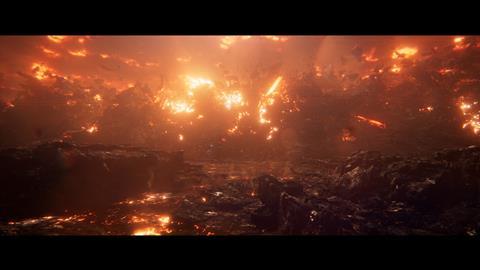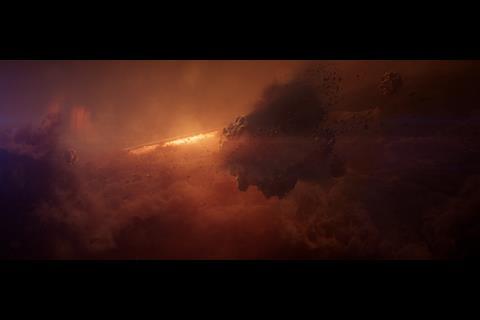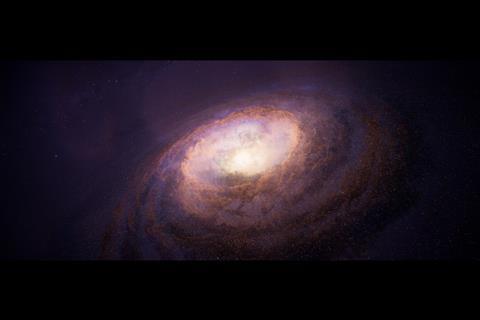VFX house worked with the BBC Studios Science Unit on the six-part docuseries
Bristol-based VFX house Lux Aeterna has revealed its work on Netflix docuseries Our Universe.
Lux Aeterna worked with the BBC Studios Science Unit on the show, which premiered on 22 November. It sees Morgan Freeman narrating as viewers are taken on a fascinating journey to discover how all ingredients of life ended up on Earth.
Lux Aeterna completed over 700 shots over the course of two years for the BBC-produced, Netflix-commissioned project, with its work representing major cosmological events, from the Big Bang, to the end of the universe.
Despite the scientific and educational elements, the focus across the production was more on creating a cinematic feel to the final edit. In fact, director/producer Stephen Cooter who directed two of the episodes alongside Alice Jones and Naomi Austin, lists his reference points more in line with the films of J.J. Abrams and Steven Spielberg than with traditional documentaries like Our Planet. The scale of the story necessitates this, switching in a moment from real-world wildlife footage to rogue asteroids and galactic collisions.

This resulted in a large project for Lux Aeterna. For a sequence where our Moon was formed from Earth’s collision with a Mars-sized rock known as Theia, real-world space data was provided by Durham University’s Dr Jacob Jegerris, a postdoctoral researcher at NASA. 30TB of data was processed into the various formats needed to create the shots. With over 100 million points per frame, 1.4 trillion data points were processed for the scene. Houdini, Maya and Nuke were used predominantly, with a number of in-house tools being developed to deal with specific challenges. ShotGrid production management software was added to Lux Aeterna’s pipeline and is now used on all the studio’s projects.
Paul Silcox, VFX director at Lux Aeterna and VFX supervisor on Our Universe, said: “The amount of data was certainly a challenge. We had to change quite a few things about the way we work to manage, but now we have a robust and powerful pipeline to expand on what we put in place for Our Universe, and work on even larger projects in the future.”
In addition to technical accuracy, Our Universe also aims to realise invisible forces. For example, when showing solar winds or Earth’s magnetic field.

Cooter said: “Although this is a universe series, how we visualise the science on screen connects the audience to the drama. Lux Aeterna was crucial to that, presenting an artistic, almost magical realist, interpretation of these ideas, but with an authenticity which keeps it grounded in terms of presentation.”
Silcox added: “There’s always a challenge to creating things you can’t actually see. A lot of these stories have been told before, but what we had to do was find new ways to show them with a compelling narrative, while maintaining a cinematic aesthetic. It’s about giving the artists the freedom to deliver the brief.”
This freedom and flexibility was felt across all aspects of production. While shooting a scene involving the hibernation of a Alaskan Brown Bear, Cooter utilised virtual production to realise his vision both creatively and safely. The shot was storyboarded to entail a mother bear waking up from hibernation and looking up at the moon. These moments of connection between animal and universe were crucial to the series storytelling, but difficult and potentially dangerous to shoot in the wild.
Instead, the team utilised an LED studio in Budapest, photographing a bear on a virtual stage for the very first time. The European Brown Bear, called Koda, was provided by Hungarian animal training company Horkai. On set, the priority was ensuring the animal was treated humanely, while still allowing the crew to film safely from a distance with the use of a technocrane. The final shot was achieved with matte painted plates, a virtual stage bear, and CGI to add clouds and other atmospherics.
Supervising such a technically complex shot, Rob Hifle, Lux Aeterna creative director, was able to give instant feedback on incorporating the post process, including VFX removals for any safety equipment required to contain the bear. The virtual wall technology enabled instant adjustments to the backdrop and lit the subject, bedding it into the scene in a way that is not possible with green screen, producing a VFX shot largely in-camera with only minimal work required in post.
Cooter said: “Having a VFX supervisor on location is incredibly helpful because you have someone there that can say ‘yes, you’ve got it’, or ‘no you haven’t’. Being able to ask if any potential issues can be fixed in post completely streamlines the process, enabling us to make decisions in real time. We reached the heart of the story we were trying to tell quicker, rather than spending time trying to fix things easily handled in post.”
Studio images: Stephen Cooter


































No comments yet